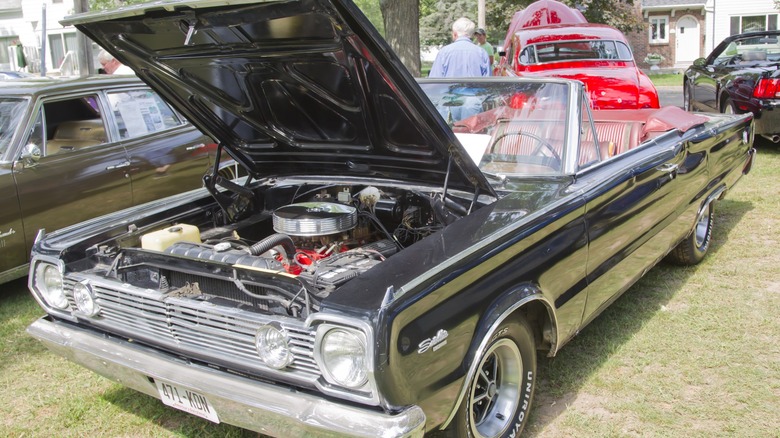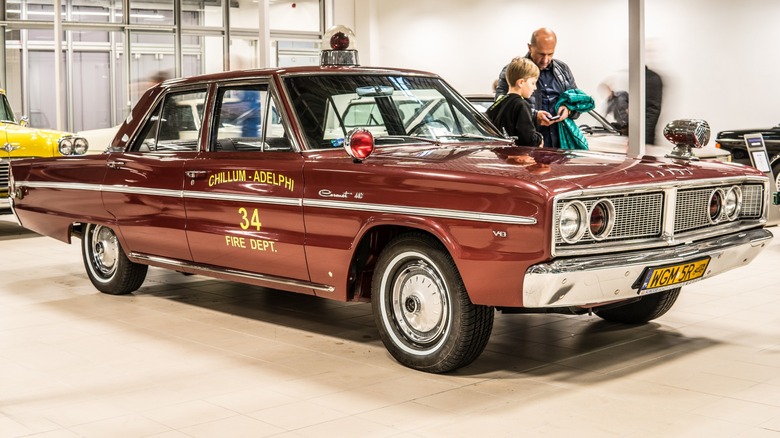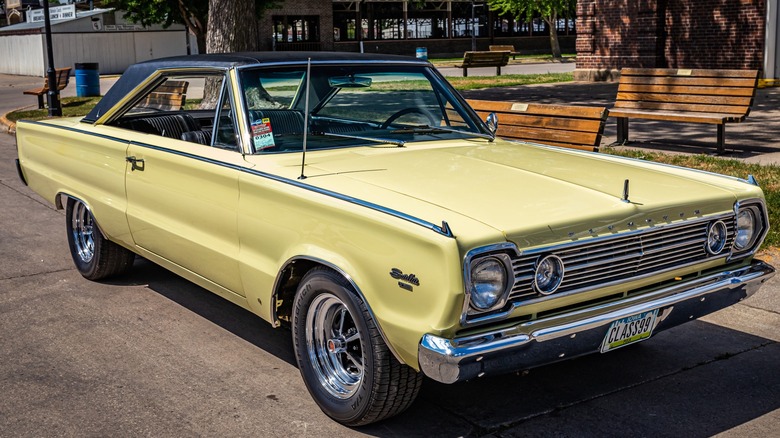
Keith Bell/Shutterstock
By Ron King/
You’d expect to find a 426 Street HEMI engine in late 1960s and early 1970s muscle cars like the Dodge Challenger, Charger, and Super Bee; the Plymouth Road Runner and Superbird; and most certainly the Plymouth Barracuda designated as the HEMI ‘Cuda for 1970 and 1971. You also might not be surprised to find a HEMI under the hood of any Chrysler model with a name that includes «Daytona.» And, you probably already know that Ram trucks have been HEMI-powered since 2003 after the commercial featuring Jon Reep aired on television asking Ram truck drivers if «That thing got a HEMI?«
Some less likely, but still predictable, HEMI-powered cars include anything with an R/T, SRT, or SRT-8 badge, like the Dodge Coronet R/T, Dodge Magnum R/T and SRT-8, Chrysler 300C SRT-8, and Jeep Grand Cherokee SRT and SRT-8. However, there are five cars that came with HEMI engines that may surprise you, some with the Gen 2 426 Street HEMI and newer models featuring a Gen 3 HEMI under the hood.
1966 Dodge Coronet

Grzegorz Czapski/Shutterstock
Many Mopar fans already know about the Dodge Coronet, produced from 1949 until 1976 in two- and four-door versions, and its role in muscle car lore. Over the years, engine options included a 230-cubic inch flat-head-six with 103 horsepower, the 241-cubic inch Red Ram (a first-generation HEMI), the big-block 440, and the legendary 425-horsepower 426 Street HEMI.
Dodge only offered the 426 HEMI option across the entire Coronet model lineup for 1966. After that single year, Coronet buyers could only get the powerful HEMI in the Coronet R/T trim. Imagine in 1966 being able to buy a four-door Dodge Coronet with a 426 HEMI. Kind of like a mullet, except the party is in the front.
Looking back in time it would seem that ordering a 1966 Coronet with four doors would be a sensible choice for anyone with a family, and while they were picking out options for paint and wheel covers, they might as well get the HEMI engine. However, in 1966 the HEMI option added over $900 to the price, almost $9,000 in today’s money. The added cost resulted in the production of just over 700 HEMI-powered two- and four-door Coronets out of a total production run of more than 200,000.
1966 Plymouth Belvedere Satellite

Gestalt Imagery/Shutterstock
Like the Dodge Coronet, the Plymouth Belvedere, including the upscale Satellite trim (before the Satellite became a stand-alone nameplate in 1971), only had the 426 Street HEMI option for the 1966 model year. The 1966 Plymouth Belvedere Satellite was based on Plymouth’s new B-body intermediate platform, reducing the size of the Belvedere from full- to midsize.
Adding the $907.60 HEMI option to the 1966 Plymouth Belvedere not only put the 426 Street HEMI under the hood, it also came with improved suspension components, upgraded brakes, and special Goodyear tires. Buyers also had a choice between a heavy-duty Torqueflite automatic or manual shift «four-on-the-floor» four-speed transmission.
R.M. Sotheby’s states that Car and Driver tested of a HEMI-powered 1966 Plymouth Belvedere Satellite, and it had a quarter-mile time of 13.8 seconds. The roughly 3,300-pound Belvedere also accelerated from 0-60 mph in 5.3 seconds and had a top speed of 130 mph.
Jeep Wrangler Rubicon 392
Jeep introduced the Wrangler Rubicon 392, one of the most powerful Jeeps ever built, in 2021, a move that MotorTrend says finally gave «Jeep fans the Wrangler they longed for.» Unfortunately, 2024 is the final year for the Wrangler Rubicon 392 since the HEMI engine is being discontinued.
Jeep lists the 2024 Wrangler Rubicon 392 for sale with an MSRP starting at $92,140, and the Rubicon 392 Final Edition at $100,590. Compared to the $51,890 starting MSRP of the V6-powered four-door 2024 Wrangler Rubicon, the Final Edition 392 is a $48,700 upgrade. That’s a substantial increase over the $907.60 price of the 1966 Street HEMI option, which would have been less than $10,000 in today’s money.
Yes, the Rubicon 392 Final Edition comes with lower estimated fuel economy ratings than the V6 Rubicon, but it also has 470 horsepower, an upgraded 8-speed automatic transmission, steel bumpers, an integrated off-road camera, air intake hood scoop, 17 x 8-inch beadlock-capable wheels, acoustic laminated front door glass, upgraded 4-wheel disc brakes, rock sliders with side steps, and flared fenders. Inside you’ll find premium touches like 392 Final Edition Nappa leather seat coverings and 8-way power adjustable front seats with 4-way power adjustable lumbar support. Also, standard is the Uconnect 5 12.3-inch touchscreen with GPS navigation, and the Alpine Premium Audio System.
That long list doesn’t even cover all the standard upgrades of the Rubicon 392 Final Edition. While some of these upgrades are optional on the V6 Rubicon, others aren’t available at all.
[Featured image by HJUdall via Wikimedia Commons | Cropped and scaled | Public Domain]
Jeep Commander
The Jeep Commander was Jeep’s first three-row SUV offering seating for seven passengers. While it was only in production for six model years (2005-2010), it had a HEMI engine option for all of them. For the first few model years the Commander’s 5.7L HEMI engine made around 330 horsepower, but Stellantis announced a more powerful 5.7L HEMI for the 2009 Commander in August of 2008.
The new 5.7L HEMI made up to 357 horsepower and 389 lb-ft of torque thanks to the new Variable Valve Timing (VVT) system. In addition to VVT providing improved engine breathability, the new 5.7 HEMI also featured MDS, short for Multi-Displacement System. The MDS is designed to improve fuel economy by deactivating four of the eight cylinders when power demand is low.
If you’re looking for a new three-row Jeep SUV you’re limited to the 2024 Jeep Cherokee L with a starting MSRP of $40,035 for the Laredo trim. However, if you had your heart set on a HEMI engine, you’ll be disappointed as the Cherokee Laredo L’s only engine offering is a 3.6L Pentastar V6.
Dodge Durango
The 2024 Dodge Durango R/T Plus (starting at $54,270), SRT 392 (starting at $74,995), and SRT Hellcat (starting at $95,995) are the last in a long line of HEMI-powered Dodge Durangos. While the SRT Hellcat badge on the newest Durango hinted at the HEMI under the hood, we were surprised by HEMI-powered Durangos dating back to 2004 when its appearance was more «soccer family» than sporty.
The 5.7L HEMI in the 2004 Dodge Durango made 335 horsepower and 370 lb-ft of torque. With its HEMI power, the 2004 Durango not only put the sport in SUV, it also added a fair amount of utility. MotorWeek tested a 2004 HEMI Durango SLT and reported 0-60 mph acceleration at 7.6 seconds. The 2004 HEMI Durango delivered useful amounts of utility with its 8,950-pound trailer towing capacity.
Dodge reports the latest 5.7L HEMI Durango has 360 horsepower and 390 lb-ft of torque capable of propelling the 2024 Durango R/T Plus from 0-60 mph in 6.2 seconds with a towing capacity of 7,400 pounds. The second HEMI engine option is the 6.4L HEMI with 475 horsepower and 470 lb-ft of torque capable of sprinting the Durango SRT 392 from 0-60 mph in 4.4 seconds, while increasing the towing capacity to 8,700 pounds. If you still want more power, opt for the supercharged 6.2L Hemi with 710 horsepower and 645 lb-ft of torque to rocket the Durango SRT Hellcat to 60 mph in 3.5 seconds, while keeping the same 8,700-pound towing capacity as the 6.4L HEMI.
[Featured image by Karrmann via Wikimedia Commons | Cropped and scaled | CC BY-SA 3.0]